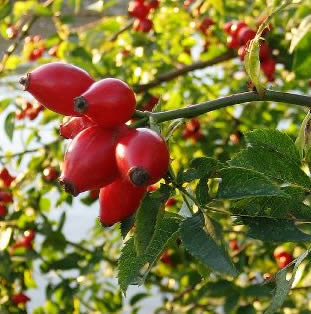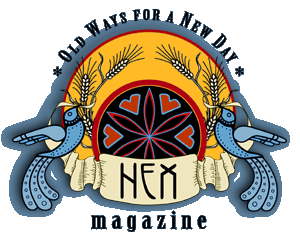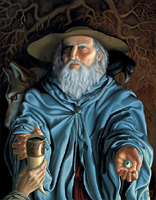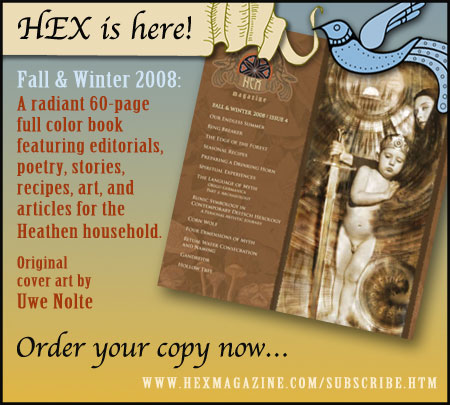~ THE TURNING OF THE WHEEL ~
WINTERNIGHTS / SAMHAIN
2008

. : . Harvest Queen . : .
sunlight glints off auburn crown
silver streaks shining through the mistbare throat dripping with jewels
voluptuous fruit from burgeoning boughlurid pink and gaudy yellow
deepen into bittersweet and burnished umbertightly wound buds opened now to lustrous bloom
lush petals tossed to the adoring earthrising sap overflows from heartwood home
sticky sweet and fragrantthe bright spark of youth now smolders to a steady glow
oracles dance through coal black eyesquickening winds reveal lithe naked limbs
bright mantle cast off to greet the coming night…~ Arrowyn Craban
* * * * * *
BLÓT
“Bluostar…is an offering of blood, and of the life of the animal….blót appears in Old English, Old Norse, and Old Icelandic; blótan is preserved within the Gothic tongue. All of these stem from respective terms for blood: OHG bluot, OE blód, ON/OI blóð, GO blóþ. Undoubtedly, bluostar is a mystery that has been collectively shared among the pan-Germanic tribal Heathen since the earliest of times.”
~ Germanic Heathenry by James Hjuka Coulter1
The month of November is rapidly approaching and for the farming cultures of Heathen Europe this time of year had special meaning. For the Anglo-Saxon peoples it was called Blótmónaþ or Sacrifice Month and the Icelandic peoples called it Gormánuðr or Slaughter-Month. It was the time when the bloody business of butchering the farm animals took place, and a time of feasting.
“…cattle and horses were killed and the altars reddened with blood and blót made, and the prayer performed that should be made for good seasons.”
(Óláfs saga helga, ch.107 as translated by Ben Waggoner)2For our hearth Blót has taken on new meaning since we harvested our Nubian goat Billy Jack. He first came to our household as an orphan in the early Spring of 2007, after his mother had abandoned him. He was tiny, cute, very affectionate and needed a bottle at all hours of the day and night. A year later he was as big as a mule deer, and even with the loss of his testicles, he had 8-inch horns and knew how to use them.
Matt, my husband, and I had decided that it was time for his harvest. So we planned to start our butchering in the Spring of 2008, however one thing after another prevented us until it had been put off a couple of months, but summer heat was rapidly approaching and Billy wasn’t getting any smaller, so we had no time to waste.
That morning we poured some corn on the ground and led Billy out of his pen with a harness. As he bent his head down to eat, I placed my hand over him and we spoke words of dedication, to our Gods and Goddesses, to our Ancestors, and to the use of the meat we would be harvesting and, yes, words of thanks to Billy for yielding his life to our nourishment.
Matt placed the rifle barrel near the back of his head where he thought it would not deflect the bullet, since goats have a bony plate on the front of their skull we didn’t want the bullet to kick back.
The first shot dropped him like a rock. The finality of his death was a sudden shock to my system and I began to feel as if I were in a surreal world. Matt used the huge boar spear blade he had gotten the year before as a Yule gift to bleed him out.
Seeing this life blood being released, I had thoughts of such deeds being performed, in one way or another, over many generations, by my ancestors. His blood – lots of it – flowed out; it was very red and thick. Later as splashes of this blood dried it became almost black. The chill in the air and the warmth of the blood caused steam to rise as if already sending our words and actions to another world.
Jake, who was joining our sippa, had arrived to help out and the butchering commenced for real. Off went the hide and the many parts or “cuts” were separated and put away to chill for a few days before freezing. It’s a good thing we had an extra old refrigerator because we filled it up.
When the guys were finished we held our first ‘real’ Blót. I dedicated the meat we had harvested that day to the nourishment of our spiritual connection to the Gods and our ancestral ties, then reddened the outside altar, our sippa/kindred banner and the guys, then they reddened me in return. It was a solemn occasion, never to be forgotten. These many months later the blood has slowly been washed away from our altar by the rain, but our banner will always carry signs of this bond we created.
My mind turned to something I have heard many people say, that in the old world the death of an animal was an everyday thing and not as dramatic, or thought provoking, as it is today. I used to agree with them, but I don’t think that’s true now. Taking the life of something you have known and cared for, always gives you pause. Or why would Blót be such a sacred act? I know I will never see it the same way again.
Today the livestock we eat are usually treated in horrific ways, almost like non-entities, as they give their life to nourish our bodies. No honor is given to those we know are capable of carrying our words to the Gods and Goddesses. So, when you are preparing your holiday feasts and set aside a plate to put out for the wights or to burn in the fire, remember to give honor to these animals who will be the main course before sending their magan and your words into the Nine Worlds.
~ Teresa (Hedgewife) Luedke
Kiefernwald Sippe1.Coulter, James Hjuka. Germanic Heathenry, A Practical Guide (1st Books Library, 2003) page 155.
2. Our Troth, Living The Troth, Vol. 2 (Book Surge Publishing, 2007) page 323.Cooking a Goat Roast
I was pleasantly surprised at how tasty goat meat, cooked properly, could be. The noble god Thor had two goats (Tanngrisni gab-tooth and Tanngnost tooth grinder) and seemed to share them often. If you don’t happen to have some goat in the freezer, try the meat market at an international grocery store – many countries eat goat regularly.Marinate the roast overnight by placing it in a non-metal container with 2 cups of white wine and a jar of onion salsa, I used Vidalia Onion Salsa. The next day preheat the oven to 350°. Put a few tablespoons of oil in the bottom of a roasting pan – this meat has very little fat – and place the meat and marinade in the pan. Sprinkle on about a teaspoon or two of salt, cover with parchment paper, then seal it all shut with aluminum foil. Keep the foil off the meat and marinade.
Roast for about 1 hour at 350° then reduce the temperature to 300° and cook for about another hour, check to see if the meat is falling from the bones yet, if not go another 30 minutes to an hour. Recover and let it rest ’till it’s cool enough to strip from the bone and put it in a bowl so you can sprinkle on some of the juice from the pan to keep it from getting dry. Serve it plain or with your favorite barbecue sauce.
* * * * * *

• EHWAZ •
Horse is, before warriors, the joy of noble folk,
A horse hoof-proud, when the warriors around it,
Wealthy on steeds, exchange speech;
And it is, to the wanderer, ever a benefit.
~ Rune poem translation by Sweyn Plowright
http://www.mackaos.com.au/Rune-Net/Primer/
Horse sees itself
In the eyes of its rider.
Kinds ride together,
Upon the rhythm,
As the rhythm.Leaves fall. Harvest is brought in. Libations are offered and hopes fulfilled or dashed. Thus as the shadows lengthen into the oncoming winter, it is our connection to others, the exchange of our speech, that become our salvation.
Love is the heart of life – it binds together generations, friends, family, lovers, fighters, and all the impulses and riches of nature. So at Winternights it comes time for us to give our thanks for love, for the connections of heart to heart; steed to atheling; mystery to magician; parent to child; friend to friend; hope to hope.
The cold air of winter’s coming can steal your breath from your lips and the warmth from your heart. There is a silence that comes in the cold season, a silence and a longing.
Let us therefore ward, warm, and welcome our hearts in the community of our shared suffering and celebration. Time is a spiral track, coiled around the trunk of the World Tree. If we have the courage to wander the path together then we might again pass into the light of a dawning spring.
* * * * * *
Madeline von Foerster
Solo Show Opening: Nov. 7, 2008 7pmWALDKAMMER
Strychnin Gallery, Boxhagenerstrasse 36
10245 BERLIN
For more information: www.strychnin.com
* * * * * *
Hex needs your help! This is a community-supported not-for-profit publication. You can support us by clicking the link above and ordering magazines and prints, and spreading the word to all like-minded folk!
* * * * * *
CALLING ALL MERCHANTS, ARTISANS, & MUSICIANS:
If you have something to sell and are interested in finding out more information about (or better yet, participating in the planning of) the upcoming Hex Folk Market — an online market in celebration of European Folk Ways and sustainable living — please respond to this email stating your interest, and I will add your address to a separate list just for merchants. I am depending upon your opinions and your participation! cheers, ~Arrowyn
Until Jule, may you and your
household be blessed and kept. Hail!
~ HEX Magazine
* * * * * *













Leave a Reply